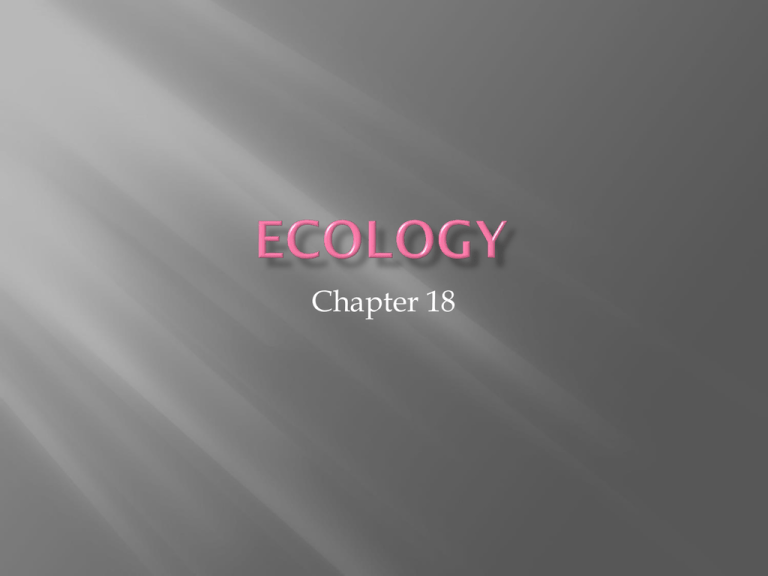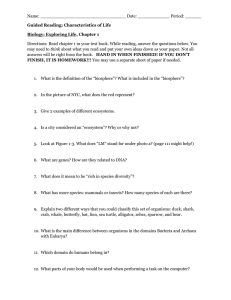ECOSYSTEMS. - Doral Academy Preparatory
advertisement

Chapter 18 The biosphere consists of all life on Earth and all parts of the Earth in which life exists, including land, water, and the atmosphere. Ecology is the scientific study of interactions among and between organisms and their physical environment. Interactions within the biosphere produce a web of interdependence between organisms and the environments in which they live. Organism Population Community Ecosystem Biome Biosphere Population—a group of individuals that belong to the same species and live in the same area Community—an assemblage of different populations that live together in a defined area Ecosystem—all the organisms that live in a place, together with their physical environment Biome—a group of ecosystems that share similar climates and typical organisms Biosphere—our entire planet, with all its organisms and physical environments A) the study of environmental pollution and overpopulation. B) the study of relationships between organisms and their environment. C) the attempt to control environmental pollution and overpopulation. D) another name for the science of biology. - The biosphere’s systems are called ECOSYSTEMS. - All ecosystems must have a constant source of energy (usually the sun) and cycles or systems to reuse raw materials. Examples are the water, nitrogen and carbon cycles. A) A group of individuals of the same species that live in the same ecosystem B) All the abiotic parts of the environment C) The total number of different species in any one area D) Air, water, soil, or climate The biological (living) influences on organisms are called biotic factors. Physical (nonliving) components of an ecosystem are called abiotic factors. A biotic factor is any living part of the environment with which an organism might interact, including animals, plants, mushrooms and bacteria. An abiotic factor is any nonliving part of the environment, such as sunlight, heat, precipitation, humidity, wind or water currents, soil type, etc. A) plant life. B) soil type. C) rainfall. D) temperature. A) average temperature of the ecosystem B) type of soil in the ecosystem C) number and kinds of predators in the ecosystem D) concentration of oxygen in the ecosystem For most life on Earth, sunlight is the ultimate energy source. For some organisms, however, chemical energy stored in inorganic chemical compounds serves as the ultimate energy source for life processes. Plants, algae, and certain bacteria can capture energy from sunlight or chemicals and convert it into forms that living cells can use. These organisms are called autotrophs. Autotrophs are also called primary producers. Primary producers harness solar energy through the process of photosynthesis. The best-known and most common primary producers harness solar energy through the process of photosynthesis. Deep-sea ecosystems depend on primary producers that harness chemical energy from inorganic molecules such as hydrogen sulfide. The use of chemical energy to produce carbohydrates is called chemosynthesis. Organisms that must acquire energy from other organisms by ingesting in some way are known as heterotrophs. Heterotrophs are also called consumers. Carnivores kill and eat other animals, and include snakes, dogs, cats, and this giant river otter. Scavengers, like a king vulture, are animals that consume the carcasses of other animals that have been killed by predators or have died of other causes. Decomposers, such as bacteria and fungi, feed by chemically breaking down organic matter. The decay caused by decomposers is part of the process that produces detritus— small pieces of dead and decaying plant and animal remains. Herbivores obtain energy and nutrients by eating plant leaves, roots, seeds, or fruits. Common herbivores include cows, caterpillars, and deer. Omnivores are animals whose diets naturally include a variety of different foods that usually include both plants and animals. Humans, bears, and pigs are omnivores. Detritivores, like giant earthworms, feed on detritus particles (broken down organic material), often chewing or grinding them into smaller pieces. Detritivores commonly digest decomposers that live on, and in, detritus particles. A) grass plant in a lawn. B) chicken raised on a farm. C) farmer who raises corn. D) earthworm in a cornfield. A) By using light energy to make carbohydrates B) By using chemical energy to make carbohydrates C) By changing water into carbon dioxide D) By breaking down remains to make carbon dioxide A) herbivore, decomposer B) producer, heterotroph C) carnivore, consumer D) autotroph, herbivore A) producer. B) autotroph. C) heterotroph. D) carbohydrate. A series of steps in which organisms transfer energy by eating and being eaten Energy flows through an ecosystem in a oneway stream, from primary producers to various consumers. Notice that arrows depict energy flow. When disturbances to food webs happen, their effects can be dramatic. Given the structure of this food web, a drop in the krill population can cause drops in the populations of all other members of the food web shown. Each step in a food chain or food web is called a trophic level. Primary producers always make up the first trophic level. Various consumers occupy every other level. Some examples are shown. Organisms expend much of the energy they acquire on life processes, such as respiration, movement, growth, and reproduction. Most of the remaining energy is released into the environment as heat—a byproduct of these activities. On average, about 10 percent of the energy available within one trophic level is transferred to the next trophic level. The total amount of living tissue within a given trophic level is called its biomass. The amount of biomass a given trophic level can support is determined, in part, by the amount of energy available. A) used in reproduction. B) stored as body tissue. C) stored as fat. D) eliminated as heat. A) animals. B) protein. C) chemicals. D) sunlight. A) consumers B) decomposers C) producers D) scavengers Unlike the one-way flow of energy, matter is recycled within and between ecosystems. Carbon is a major component of all organic compounds, including carbohydrates, lipids, proteins, and nucleic acids. Carbon dioxide is continually exchanged through chemical and physical processes between the atmosphere and oceans. Plants take in carbon dioxide during photosynthesis and use the carbon to build carbohydrates. Carbohydrates then pass through food webs to consumers. Organisms release carbon in the form of carbon dioxide gas by respiration. Geologic forces can turn accumulated carbon into carbon-containing rocks or fossil fuels. Carbon dioxide is released into the atmosphere by volcanic activity or by human activities, such as the burning of fossil fuels and the clearing and burning of forests. The nitrogen cycle describes how nitrogen moves between plants, animals, bacteria, the atmosphere (the air), and soil in the ground. Nitrogen is an important element to all life on Earth. For Nitrogen to be used by different life forms on Earth, it must change into different states. Nitrogen in the atmosphere, or air, is N2. Other important states of nitrogen include Nitrates (N03), Nitrites (NO2), and Ammonium (NH4). Fixation - Fixation is the first step in the process of making nitrogen usable by plants. Here bacteria change nitrogen into ammonium. Nitrification - This is the process by which ammonium gets changed into nitrates by bacteria. Nitrates are what the plants can then absorb. Assimilation - This is how plants get nitrogen. They absorb nitrates from the soil into their roots. Then the nitrogen gets used in amino acids, nucleic acids, and chlorophyll. Ammonification - This is part of the decaying process. When a plant or animal dies, decomposers like fungi and bacteria turn the nitrogen back into ammonium so it can reenter the nitrogen cycle. Denitrification - Extra nitrogen in the soil gets put back out into the air. There are special bacteria that perform this task as well.








